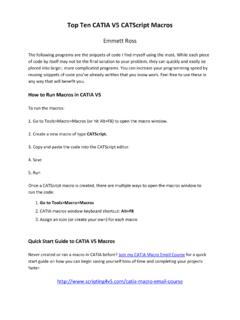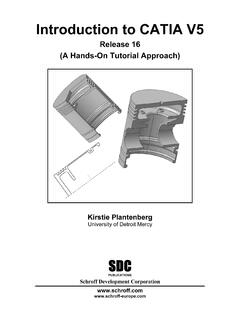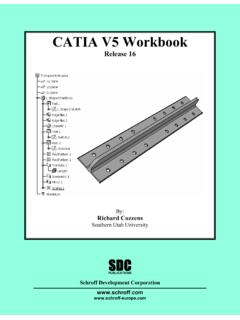Transcription of Design and Analysis of Honey Comb Structures with ...
1 2015 IJEDR | Volume 3, Issue 4 | ISSN: 2321-9939 IJEDR1504023 International Journal of Engineering Development and Research ( ) 144 Design and Analysis of Honey Comb Structures with Different Cases 2 Shaik Allabakshu 1 Post Graduate Student 2 Assistant Professor Dept. of Aerospace Engineering, Nimra Institute of Science & Technology,Vijayawada-521456 _____ Abstract - Honeycomb Structures are natural or man-made Structures that have the geometry of a honeycomb to allow the minimization of the amount of used material to reach minimal weight and minimal material cost. Types of honeycomb Structures are depend upon the geometrical shape. There are different types of honeycomb core Structures like square, hexagonal, pentagonal, tetrahedral, pyramidal etc. In this project we are comparing the structural Analysis for square and hexagonal honeycomb Structures and thermal Analysis of square and hexagonal honeycomb Structures .
2 Structural Analysis is the determination of the effects of loads on physical structure. To perform an accurate Analysis an engineer must determine such information as structural loads, geometry, support conditions, and materials properties. The results of such an Analysis typically include deformation, stresses and displacements. This information is then compared to criteria that indicate the conditions of failure. Thermal Analysis calculates the temperature distribution and related thermal quantities in the system or component. Typical thermal quantities of interest are: The temperature distributions:(a) The time to reach steady state,(b) The steady state temperature distribution (using a transient Analysis ),(c) The temperature distribution after 50 seconds;The amount of heat lost or gained; Thermal gradients; Thermal fluxes.
3 Key words - catia modelling of the product, static Analysis , Structural Analysis , Thermal Analysis , strength _____ Nomenclature - 1. catia Computer Aided Three-dimensional Interactive Application 2. DOF Degree of freedom 3. UDL Uniform Distributed Load 4. ANSYS Analysis of Systems I. INRODUCTION What is a honeycomb structure? Honeycomb Structures are natural or man-made Structures that have the geometry of a honeycomb to allow the minimization of the amount of used material to reach minimal weight and minimal material cost. The geometry of honeycomb Structures can vary widely but the common feature of all such Structures is an array of hollow cells formed between thin vertical walls. The cells are often columnar and hexagonal in shape. A honeycomb shaped structure provides a material with minimal density and relative high out-of-plane compression properties and out-of-plane shear properties.
4 Fig 1 Honeycomb structure Man-made honeycomb structural materials are commonly made by layering a honeycomb material between two thin layers that provide strength in tension. This forms a plate-like assembly. Honeycomb materials are widely used where flat or slightly curved surfaces are needed and their high strength is valuable. They are widely used in the aerospace industry for this reason, and honeycomb materials in aluminium, fibreglass and advanced composite materials have been featured in aircraft and rockets since the 1950s. They can also be found in many other fields, from packaging materials in the form of paper-based honeycomb cardboard, to sporting goods like skis and snowboards. The main use of honeycomb is in structural applications. The standard hexagonal honeycomb is the basic and most common cellular honeycomb configuration.
5 2015 IJEDR | Volume 3, Issue 4 | ISSN: 2321-9939 IJEDR1504023 International Journal of Engineering Development and Research ( ) 145 Honeycomb composites Natural honeycomb Structures occur in many different environments, from beehives to honeycomb weathering in rocks. Based on these, man-made honeycomb Structures have been built with similar geometry to allow the reduction of the quantity of material used, and thereby realizing minimal weight and material cost. Fig 2 Honeycomb structure with panels Man-made honeycomb Structures have an array of hollow cells formed between thin vertical walls, so that the material has minimal density, strength in tension and high out-of-plane compression properties. Geometric types of honeycomb Structures In geometry, a honeycomb is a space filling or close packing of polyhedral or higher-dimensional cells, so that there are no gaps.
6 It is an example of the more general mathematical tiling or tessellation in any number of dimensions. Honeycombs are usually constructed in ordinary Euclidean ("flat") space. They may also be constructed in non-Euclidean spaces, such as hyperbolic honeycombs. Any finite uniform polytope can be projected to its circumsphere to form a uniform honeycomb in spherical space. II. EXPERIMENTAL DETAILS A. Design Methodology First level or preliminary Analysis of Design uses tools that have to be simple to Design the Hexagonal cell structure and then extrude. After that Assembly of group of Hexagonal cells will be generated for some cases for Analysis Second level is level of Design of panel of the rectangle .Computer codes are based on finite difference methods or finite element methods, with 1D, 2D or 3D models of physical phenomena (internal ballistics, fluid dynamics, continuum mechanics structural Analysis ).
7 They allow precise calculations, or optimization up to defining final geometry. B. Problem Definition To perform an accurate Analysis an engineer must determine such information as structural loads, geometry, support conditions, and materials properties. The results of such an Analysis typically include deformation, stresses and displacements. This information is then compared to criteria that indicate the conditions of failure. C. Material Selection On the key Design of the structure we are analyzed with different type of material like Aluminum, Titanium and have an clear over view on all categories and make an clear results Type of material Deflection values(meters) CASE-1 Apply pressure on one side by keeping other side DOF as zero Aluminum Titanium CASE-2 Cantilever beam with point load Aluminum Titanium CASE-3 Cantilever beam with uniformly distributing load Aluminum Titanium CASE-4 Fixed beam with point load Aluminum Titanium D.
8 Phases of Design The catia (Computer Aided Three-dimensional Interactive Application) is a multi-platform CAD/CAM/CAE commercial software suite developed by the French company Dassault Systems . It is a very useful to modelling and drafting the tool. catia has more than 60 modules ranging from simple sketcher, part Design , drafting, sheet metal Design , Design to assembly and many endless features that are helpful in some aspects depending upon our needs, from generative shape Design to Analysis of the tool. Whether stand alone or combined for a targeted industry solution, catia delivers a combination of proven industry practices, knowledge, and business processes, along with a best-in-class digital product experience 2015 IJEDR | Volume 3, Issue 4 | ISSN: 2321-9939 IJEDR1504023 International Journal of Engineering Development and Research ( ) 146 Aerospace: The Boeing Company used catia V3 to develop its 777 airliner and used catia V5 for the 787 series aircraft.
9 They have employed the full range of DassaultSystem s' 3D PLM products catia , DELMIA, and ENOVIA LCA supplemented by Boeing-developed applications. The development of the Indian Light Combat Aircraft has been using catia V5. Chinese Xian JH-7A was the first aircraft developed by catia V5 when the Design was completed on September 26, 2000. European aerospace giant Airbus has been using catia since 2001. Canadian aircraft maker Bombardier Aerospace has done all of its aircraft Design on catia . The Brazilian aircraft company EMBRAER uses catia V4 and V5 to build all airplanes. Vought Aircraft Industries uses catia V4 and V5 to produce its parts. The Anglo/Italian Helicopter Company Augusta Westland uses catia V4 and V5 to Design their full range of aircraft. The Eurofighter Typhoon has been designed using both catia V4 and V5. The main supplier of helicopters to the Military forces, Sikorsky Aircraft Corp.
10 , uses catia as well. Bell Helicopter, the creator of the Bell Boeing V-22 Osprey, has used catia V4, V5, and now V6. III. MODELLING Here we are used the catia software to have a three-dimensional overview and make the use of some types of features representation of a person or thing or of a proposed structure, typically on a smaller scale than the Modelling in the catia Software Fig 3 Hexagonal cell Dimensions of hexagonal cell Edge length = , Radius = , , Thickness= Modelling of hexagonal cell Fig 4 Hexagonal cell extrude Create another hexagon with thickness is , using constraint 2015 IJEDR | Volume 3, Issue 4 | ISSN: 2321-9939 IJEDR1504023 International Journal of Engineering Development and Research ( ) 147 Assembly of Hexagonal cells Fig 5 Assembly of hexagonal cell Modelling of panel Fig 6 Rectangle plate Dimensions of panel Length= Width = Thickness= Here above we have designed the different phases and shapes of the Honey comb for our Analysis of the four different cases for a better case and we analyze these Structures in the software called Ansys as structural, thermal and strength as follows E.












